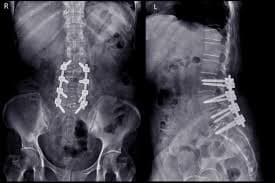Failed back surgery syndrome is a term used to describe the recurrence of symptoms after spine surgery. This can occur despite a technically successful surgery. Some studies estimate the occurrence as high as 20% to 40% of patients who undergo back surgery.

Failed Back Surgery Syndrome
Overview
Causes and Contributing Factors
FBSS can result from a combination of different factors, including:
- Improper diagnosis: The surgeon may have failed to identify the true source of the patient's pain.
- Recurrent or new spinal problems: A recurrent disc herniation or instability can occur at the same level that was operated on. Alternatively, a new issue, such as spinal stenosis or instability, can develop at an adjacent level.
- Scar tissue (epidural fibrosis): In some cases, the natural healing process can lead to the formation of scar tissue around the spinal nerves. This scar tissue can constrict the nerves and cause persistent pain.
- Inadequate decompression: The surgery may have failed to completely relieve the pressure on a pinched nerve.
- Failed spinal fusion: If a spinal fusion was performed, the bones may not have successfully fused (pseudoarthrosis), leading to continued instability and pain.
- Spine infection: Infections can lead to rapid onset of pain at the surgical site and are accompanied by fevers, chills, and drainage from the wound.
- Predisposing conditions: Factors such as obesity, smoking and tobacco use, chronic pain conditions (e.g., fibromyalgia), or mood disorders (depression, anxiety) can increase the risk of FBSS.
Symptoms
The most prominent symptom of FBSS is persistent pain that either continues after the surgical recovery period or returns months or years later.
When the spinal nerves are involved, additional symptoms may occur:
- Pain, numbness, or tingling in the legs and feet
- Muscle weakness
- Reduced mobility and difficulty with daily activities
Non-Surgical Treatments
These are almost always the first line of treatment:
- Lifestyle modifications: Maintaining a healthy weight and avoiding activities that aggravate the pain.
- Physical Therapy and Exercise: Strengthening core and back muscles to improve stability as well as regular stretching exercises to improve spine mobility. Desensitization therapies can also aid with chronic nerve pain from injury.
- Medications: Multiple types of medications can be employed, such as: nonsteroidal anti-inflammatory drugs (ibuprofen, naproxen), nerve pain medications (gabapentin, pregabalin), muscle relaxants (cyclobenzaprine), or antidepressants (amitriptyline).
- Injections: Epidural steroid injections or nerve blocks can help relieve inflammation and pain from irritated nerves.
Surgical Treatment
Revision surgery has mixed results, and it is typically reserved for cases where a specific, correctable structural problem has been identified and other treatments have failed. Repeat surgeries have a diminishing likelihood of successful outcome. Each subsequent surgery has a 50%, 30%, 15%, and 5% chance of success respectively. As a final option, spinal cord stimulation may be considered. This is a minimally invasive procedure where a small device is implanted to send electrical impulses to the spinal cord, which can block the pain signals from reaching the brain.